The Art Of Making Your Fistula Or Graft Last
By Lynda K. Ball, MSN, RN, CNN
You have been told that your access is your hemodialysis (HD) lifeline. And, it's true! But each year, some people run out of access sites. Taking steps to keep your fistula or graft healthy and working can help you have a longer, better life with kidney failure.
Learn to Recognize Stenosis
When a vein and an artery are connected by a surgeon, veins are at risk for damage to the lining due to high pressure and blood flow from the artery. This damage can cause a narrow spot in your blood vessel called a stenosis.
Two narrow areas in this mature wrist fistula

Used with permission of Tushar Vachharajani and Fistula First Breakthrough Initiative www.fistulafirst.org
The way the body tries to fix this damage is to repair the walls by laying down extra cells. The extra cells leave less and less room for blood to pass through your access. If stenosis is not found early, your access can clot.
Stenosis also occurs in grafts, where it tends to happen more often than in fistulas. Grafts have two "anastomoses" (ends that link to other vessels). One end is linked to an artery. The other end is linked to a vein. The graft material is about 6 mm in diameter and rigid. It is attached to a vein that is smaller in diameter and stretchy. As the high flow/high pressure blood rushes through the graft and into the vein, it can harm the vein wall at the venous anastomosis. A narrow vein at the end of the graft causes blood to back up into your graft and sit, so the access may clot.
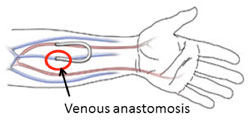
A central venous stenosis (CVC) occurs in vessels that go from your shoulders across your chest. A CVC stenosis can be caused by:
- An HD catheter that harmed the vessel it was placed in
- Heart pacemaker wires placed in the central veins
- Peripherally inserted central catheter (PICC) lines (catheters that go into your arm and end up in your heart)
- Plaque in your veins (e.g., high cholesterol)
- Blood vessel disease (e.g., diabetes)
- Upper arm high flow fistulas
There are some signs you can look for to see if you might have stenosis:
- When you listen to the bruit (brew'-ee) with a stethoscope, it sounds higher in pitch—like a tea kettle.
- Press lightly (palpate) with your fingers over the whole length of your access. A stenosis may feel like a flat spot in your fistula.
- Do the Arm Raise Technique once a month on your AV fistula. Stand in front of a mirror so you can see your whole fistula. Pump your hand and make a fist, and raise your arm straight up in the air. Watch what happens to your fistula. The whole access should collapse—not just part of it (or none of it). If there is a narrow spot, blood can't get out quickly when you do this. Drop your arm back down right after you look.
-
Look at both of your arms in a mirror. They should be the same size. A larger access arm may have a blockage in the chest area that keeps blood from draining out of the arm.
Central venous stenosis that prevents fluid draining from the access arm.
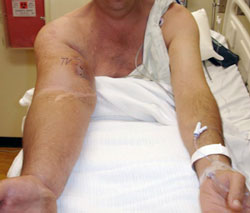
Used with permission of Tushar Vachharajani and Fistula First Breakthrough Initiative www.fistulafirst.org
- On the machine, arterial pressure (AP) is higher (more negative) than -250 mmHg. It tells you that the blood pump is having trouble pulling the amount of blood the blood pump wants. This can cause hemolysis (blood cells rupture)
- Venous pressures are high even when the blood flow rate is only 200 mL/min (more than ½ the blood pump speed). Venous pressure tells you how easy or hard it is to push blood back into your vein.
- When placing needles, blood squirts out around the needle. This tells you there is too much pressure, most often caused by the stenosis.
- It takes a long time for bleeding to stop after a treatment.
- Old aneurysms (weak spots where the access wall balloons out) get bigger, or new ones form.
Prevent Aneurysms in AV Fistulas
Aneurysms with shiny, tight, thin skin showing color change.
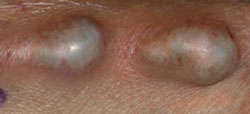
Used with permission of S. Glazer, MD
An aneurysm is damage to a blood vessel wall from placing needles into a very small area on your access. If there is very high blood pressure or a stenosis, this pressure can cause the fistula wall to balloon out. As a kid, you may have blown a balloon up so far that it burst. An aneurysm can burst, too. Know what signs to watch for, so a problem site can be fixed in time to save your life:
Scab that will not heal.

Used with permission of S. Glazer, MD
- An aneurysm on your fistula that is growing quickly – this is an emergency and needs to be seen by your surgeon right away.
- An aneurysm that is shiny, tight—sometimes so tight the color of your skin changes—and hard is a red alert. This needs to be fixed NOW! It does not matter how big or small the aneurysm is – what matters is that the vessel and skin are getting so thin that they can burst. Since a burst fistula can lose half a liter of blood each minute, do not take chances.
- A skin ulcer or blister over an aneurysm can make the skin weaker, so it may burst. This also needs to be fixed NOW!
- If your scabs are not healing or after treatment they are raised bumps—not flat—there could be high pressure behind them. If the scab is bumped or nicked, the access could burst. Have this looked at NOW!
Prevent Pseudoaneurysms in AV Grafts
Pseudoaneurysm – note the shiny, tight, discolored bump with an ulcer on top.

Courtesy of M. Silva, MD
Grafts can have problems that look like those in AV fistulas, but the cause is slightly different. When grafts are cannulated in the same small area, holes form. Blood leaks out and collects into a large bump that looks just like an aneurysm. "Pseudo" means false, so even though it looks like an aneurysm, it is really a huge blood clot (hematoma) that sits on top of the damaged AV graft. The skin over top of this huge bump becomes thin. It can rupture, causing severe loss of blood. Because grafts are foreign material, erosion and infection are other issues to watch for. The most current studies say that AV grafts are the number one access that ruptures. Knowing what to look for and telling your nurse and doctor right away of any changes to your access is vital.
Here are some signs that a pseudoaneurysm needs to be seen by a doctor:
- It is more than twice as big as your graft
- It is hard to get the bleeding to stop after a treatment
- It bleeds sometimes all by itself, when you are not on HD
If an access bursts:
- Press on the site with your fingers NOW. Do not wrap a towel around it, this can pull more blood out of your access.
- Stay calm. It can keep your heart rate lower so you bleed less.
- Raise your bleeding arm above your shoulder. This can slow bleeding because blood has to go up hill.
- Yell for help if someone else is there. Have them call 911.
- If you are alone, KEEP holding pressure – no peeking. This bleeding won't stop!
- Call 911
Improve Cannulation Technique
A fistula or graft is made for putting needles in. But, putting them in the wrong way can harm an access. As you can see in this drawing, there are three ways to put needles in a fistula or graft:
- Site rotation
- Area puncture
- Buttonhole technique
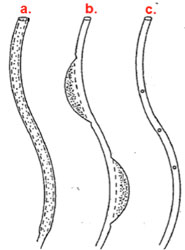
Kronung, Dial & Trans, 1984
Of the three, the Area Puncture Technique is the most likely to cause aneurysms. Avoid this! If you rotate sites, it is vital to stay at least ¼" away from the last sites and use the whole length of your access, not just parts. Keep your needle tips at least an inch and a half apart, too. NEVER cannulate aneurysms or pseudoaneurysms because of:
- Potential hemorrhage (large amount of blood loss)
- Exsanguination (massive amount of blood loss)
- Death
Always use a tourniquet to cannulate a fistula —no matter how big it is, old it is, or how skilled you are. All tourniquets should be placed loosely on your upper arm, above the bicep. But, never use a tourniquet on an AV graft – it is full and firm already and will not stretch any bigger.
Top 5 Reasons to Use a Tourniquet
- Prevents vessel damage and infiltration
- Gives you more room to cannulate
- Puts tension on the vessel wall, for less pain
- Firms up the access for assessing
- Lets you see the vessel edges
Secure the Needle
Be sure to tape the needles to keep them from falling out and causing hemorrhage.
Not safe taping!

You need at least three pieces of tape:
- Place the first piece of tape over the wings – this stabilizes the needle within the fistula or graft.
- The second piece of tape is the "chevron" (V) – this will keep your needle from falling out during HD. Place it sticky side up and cross the tape over the needle tubing and onto the skin.
- The third piece of tape should cover the needle puncture site. This will help keep germs from climbing down the needle into your sterile bloodstream.
Extra tape can be used to prevent the needle tubing from being pulled on.
The correct taping technique.
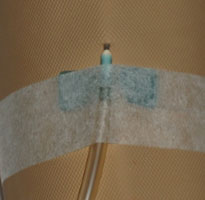

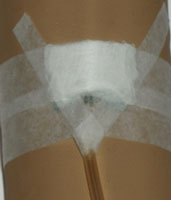
Courtesy of Lynda Ball
You can keep your access safe and healthy when you know what to watch out for. Learn the warning signs and insist on being seen right away if you see a problem.

